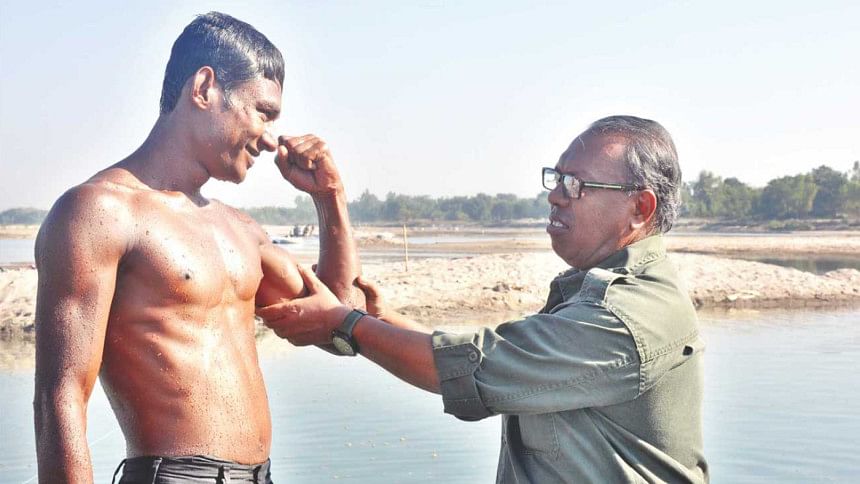The hard life of stone lifters

Every person who has been to the banks of the Mohanonda River has definitely seen labourers carrying stones on their shoulders. It's an age old practice. These stones are carried by the stream of the Mohanonda from India. The river passes Panchagarh and Tetulia to go back to the neighbouring country again. These stone-labourers work from dawn to dusk. This is a different life with backbreaking work. The river is located at the border of Tetulia upazila in Panchagarh which enters Bangladesh from India through the west of Banglabandha zero point. It travels around 32 kilometres in the country and travels back to India crossing the south of Tetulia bazaar.
Thousands of people lift stones from the river and this is the main source of livelihood in the riverside region. Stones are gifts of nature for these people. These regions include Banglabandha, Jharuapara, Jaigarijot, Paglidangi, Shonnashipara, Ukiljot, Kashimganj, Dakhhin Kashimganj, Jamdar Gochh. About 60,000 people in fifty villages make a living off of stone lifting.
During monsoon the overflowing water drown the arable lands of Bangladesh. After monsoon, almost all the year, the river has a strong current. Just a few years back the streams were wild on the river, but now it's just a narrow canal. Sands are all around. During every monsoon in the year, the streams bring in small and big stones. When the water recedes, many people jump in for lifting the stones.
I spoke to some stone lifters of the region to learn about their life and this extremely tough physical work. Fayzur was busy with his work but was kind enough to share a few words with me.
"For how long have you been lifting stones?"
"It's been thirty years."
"How much do you earn daily?"
"I work for one shift that gives me around Tk. 400, it's tough but I need to make money."
The weight Fayzur is carrying is quite unbelievable. First he has to go down to the river with a rope tied around his body. His fellow colleagues who wait on the surface drag him up using that rope. Fayzur finds a manageable stone and pushes it on to a locally made tool. It's quite a difficult task, I must say.
"The people of the north of Bangladesh live on stones. This is our source of livelihood", said another stone lifter.
The labourers here do the job constantly for ten to fifteen minutes. Then another one takes his place while the other one take rest. These stone lifters generally work under either a lessor or a trader who has taken lease of these sand areas. However these people do not own what they find, they are only working under a lessor. I found a stone trader and lessor, Hamidul Islam.
"For how long have you been involved with this business?"
"Ten to twelve years."
"How many like you are working in the region?"
"Fifteen."
"How many people are overall involved with this stone lifting, you assume?"
"Many people. These people lift stones and carry it up to the shore. We also have some women labourers."
"Do you have any investments here?"
"No."
"Which means it's a very profitable venture for you, isn't it?
"Yes."
"I have to pay the stone lifters, there's a carrying cost and also the stone breaking cost. Then, I'll sell it which will give me one or two taka profit per c.f.t.", says Hamidul.
They go down underwater and stay there for a long time and bring a basket of stones. I spoke to another stone lifter who was working for a long time.
"For how long have you been working today?"
"It's been an hour…"
"For how many years are you doing this?"
"Twelve years."

After they bring the stones out they have to separate the sand from the stones. Due to the dams set by India, a part of Mohanonda in Bangladesh territory has turned lifeless. The neighbouring country has constructed sluice gates over Mohanonda river in Fulbari inside their territory. When they open the sluice gates, water enters through Mohanonda in Bangladesh. Most of the time in the year, people lift stones. These people collect stones sometimes from knee-high water, sometimes they go up to waist-high water.
These people have been working since their childhood. Their bodies have turned as hard as stone. This place is full of natural resources. Apart from digging the river in Tetulia, people can easily get stones if they dig the plain lands up to ten feet. A recent research shows that there is huge amount of stones beneath the soil. According to Mining Engineer Dr. Kamruzzaman, there should be a proper system for lifting stones. "If we carry on extracting in an unplanned way the river bank erosion will occur. If there is a certain method for extraction in a planned way, we can prevent the erosion. So, we need the right policy. If people use dredgers (Boma machines) the whole area will collapse. This should be prohibited but I believe the manual process must go on which is an earning resource for many", adds Dr. Kamruzzaman.
The truth is that no one tries to follow rules and regulations when it's a matter of making money. The stone merchants take lease of lands at a rate of fifty to hundred thousand taka for two to three months, once they know that they will be able get stones lifted from under the soil. They dig the land and get their stones and pile those up by the side of Panchagarh-Banglabandha road. This is how stone business has become really popular in Panchagarh's Tetulia. All the roads of Panchagarh, Tetulia and Banglabandha lead to stone lifting work. The trading and breaking of stones take place right beside the highway.
But our eyes stay fixated on the tough lives of the stone lifters and their livelihood, and their lives reminds us of how the river gives life to so many people in so many diverse ways. No matter how hard the work is, this is still a means of earning a living and become independent.

Shykh Seraj is a Media and Agriculture Development Activist. He is an Ashoka Fellow and recipient of Ekushey Padak, FAO A.H. Boerma Award and many other prestigious accolades. At Channel i, he is Director and Head of News. He is also Director and Host of the popular agro-documentary, "Hridoye Mati O Manush".

 For all latest news, follow The Daily Star's Google News channel.
For all latest news, follow The Daily Star's Google News channel. 



Comments